We may not have the course you’re looking for. If you enquire or give us a call on 01344203999 and speak to our training experts, we may still be able to help with your training requirements.
We ensure quality, budget-alignment, and timely delivery by our expert instructors.
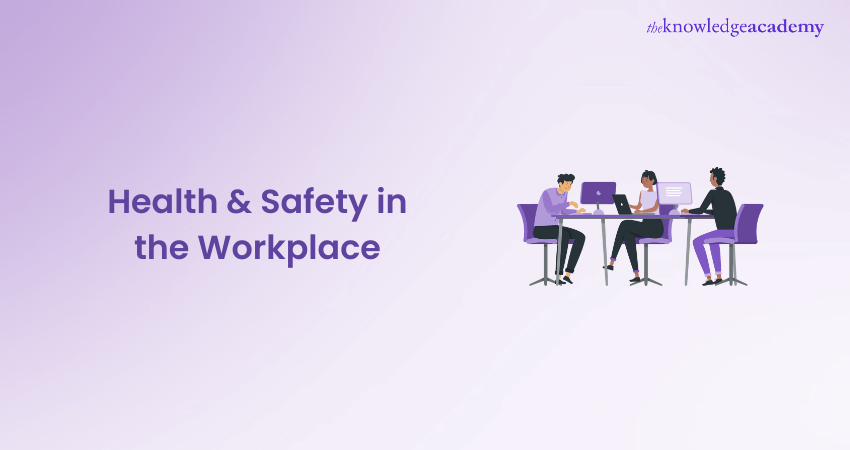
Do you know what the ideal workplace is? It's a space where every individual feels secure, valued, and empowered to always give their best. However, this scenario will remain a pipedream if the health and safety component in the workplace is overlooked. Whether in an office, construction site, or industrial environment, fostering a strong health and safety culture means integrating safety into everyday operations. This blog delves into all aspects of workplace health and safety, highlighting the responsibilities of both employers and employees in maintaining it. Keep reading to transform safety from a set of rules into a way of life!
Table of Contents
1) What is Health and Safety in the Workplace?
2) Why Health and Safety in the Workplace is Important?
3) Key Elements of Workplace Health and Safety
4) What is the Health and Safety at Work Act?
5) Who Holds Responsibility for Health and Safety in the Workplace?
6) Employers' Health and Safety Duties
7) Health and Safety Issues Faced by Employers
8) How to Maintain Health and Safety in the Workplace?
9) What is Occupational Health?
10) Role of Leadership in Workplace Safety
11) Who are the Key Health and Safety Organisations?
12) Benefits of a Safe Workplace
13) What Colour are Mandatory Signs?
14) What do the 3 P's of First Aid Stand for?
15) Conclusion
What is Health and Safety in the Workplace?
Workplace Health and Safety refers to the various policies, practices, and procedures implemented to ensure the well-being and safety of individuals within a work environment. It encompasses a comprehensive approach that addresses physical, mental, and emotional health hazards that may arise in the workplace, while also promoting Workplace Accessibility to create a safer and more inclusive work setting for everyone.
It covers a multitude of areas, including but not limited to:
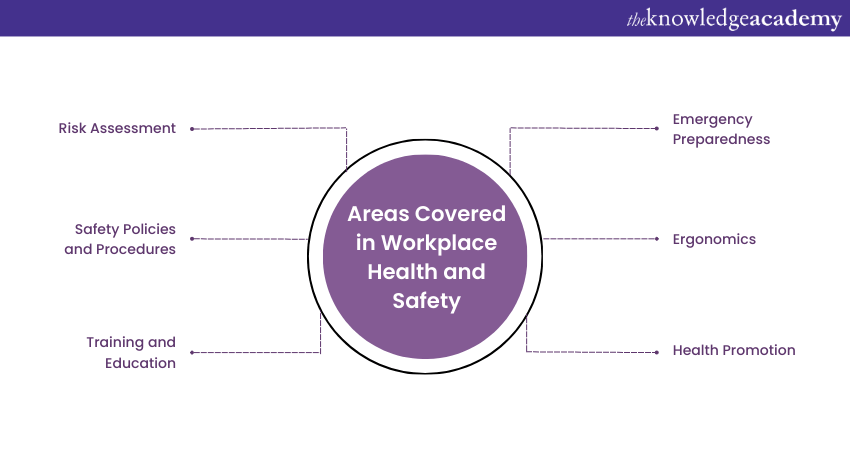
a) Risk Assessment: Identification of potential workplace hazards and assessing the associated risks to determine preventive measures.
b) Safety Policies and Procedures: Establishing clear guidelines and protocols to promote safe practices and behaviour in the workplace.
c) Training and Education: Providing employees with the skills and expertise necessary to carry out their work safely and effectively.
d) Emergency Preparedness: Developing plans and procedures to handle emergencies, such as fires, natural disasters, or medical incidents.
e) Ergonomics: Ensuring that workstations, equipment, and tools are designed and arranged in a way that minimises the risk of physical strain or injury.

f) Health Promotion: Encouraging wellness initiatives and programs to support the overall well-being and health of employees.
Why Health and Safety in the Workplace is Important?
Health and safety are essential because they protect your Employees and visitors to your business, such as customers and clients. Consider the following points:
1) Employers have a duty of care under the Health and Safety at Work Act 1974 to ensure a safe working environment.
2) Complying with health and safety laws is both a legal obligation and good business practice.
3) Failing to adhere with health and safety laws can lead to:
a) Losing staff
b) Higher recruitment costs
c) Lower retention rates
d) Reduced profitability
4) Inadequate health and safety practices can result in:
a) Illness, injury, or death
b) Legal prosecution for breaching regulations
c) Penalties such as fines, imprisonment, or even business closure
5) Workplace health and safety is essential for the health and wellbeing of Employees across all industries.
6) Employers risk being charged with corporate manslaughter in case an Employee loses their life in a workplace accident.
Ensure a safer work environment with the Occupational Health and Safety PDF—download now!
Key Elements of Workplace Health and Safety
The following table summarises the key components of Workplace Health and Safety
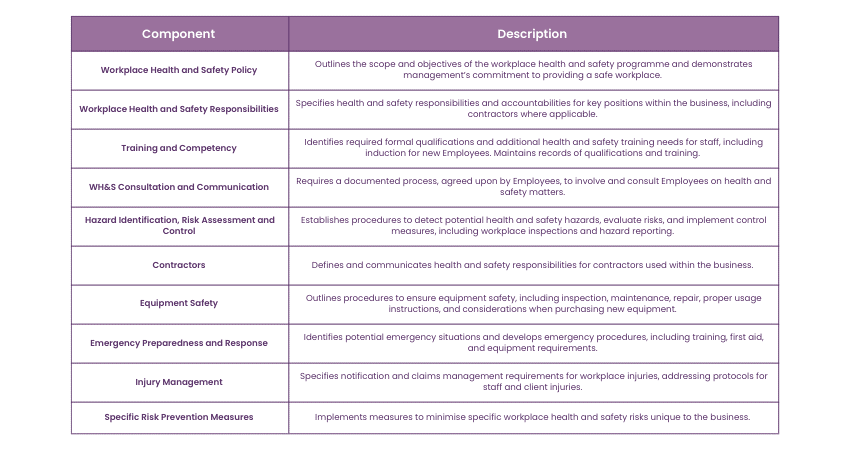
Attain in-depth knowledge about employers' fire safety responsibilities in our IOSH Fire Safety for Managers Course - Sign up now!
What is the Health and Safety at Work Act?
Workplace Health and Safety offer security and allow Employees to work more efficiently. It not only keeps the possible dangers in check but also provides necessary steps in case of an accident. Health and Safety at Workplace Act (HSW) works on such principles. It sets a framework for an organisation that keeps everyone in the work environment safe.
1) The framework includes rules and regulations for everyone, from office maintainers to the organisation's owner.
2) Additional rules are provided for workplaces requiring higher safety standards, such as construction sites and chemical industries.
3) Necessary elements like sound ventilation systems and maintenance equipment ensure workplace safety.
4) The HSW framework ensures the workplace contains essential safety elements.
5) Providing safety training to workers is a critical aspect of the act.
6) The act serves as a welfare provision for all Employees.
Employees Responsibilities for Health and Safety at Work etc Act 1974
An Employer must take care of their Employees, but it is also crucial for an Employee to take care of themselves. There are unavoidable accidents that only occur because of the carelessness of an Employee. Here are a few essential responsibilities that Employees must handle to maintain a safe and reliable work environment based on the Health and Safety at Work etc Act 1974:
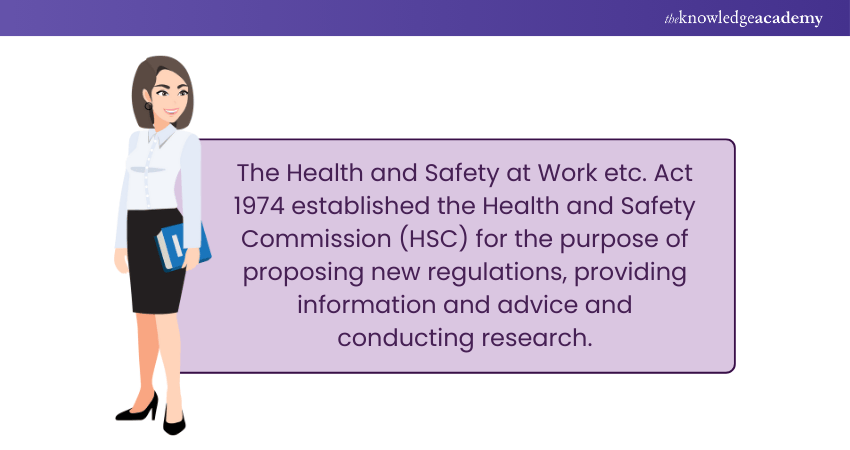
1) Do Method Statements and Risk Evaluations: A work method statement is a set of instructions that guides you through a task while ensuring your Health and Safety. If the working staff do not take these instructions seriously, they might face unnecessary dangers along the way. Risk evolution also works on the same ground.
2) Talk to the Staff About Health and Safety: An Employer must engage workers in discussions regarding Workplace Health and Safety. Sometimes, the Employer is unaware of issues lurking in the dark that only an Employee can see. Talks over these threats create an efficient communication channel, leading to better safety measures.
3) Choose Trustworthy Contractors: Having experience in maintaining workplace health and safety builds trust. Having an experienced contractor, you can trust to evaluate specific situations and take necessary steps offers safety assurance. Because of this, even if someone in the workplace encounters a mishappening, a reliable contractor can reduce it to the minimum.
Sign up for our IOSH Safety Health and Environment for Construction Site Managers Training and master key health and safety laws and enforcement practices!
4) Publish Health and Safety Regulations: Publish Health and Safety regulations are specific rules and regulations everyone must follow, irrespective of the organisation. These rules work as the minimum requirements or benchmarks for a particular industry. Not following these rules and regulations can be considered a violation of legal obligation.
5) Disseminate Information on Health and Safety: Training sessions and workshops play a critical role in maintaining efficiency with protection. An Employee can reduce potential hazards to a minimum by following practises like distributing safety manuals and sharing incident reports. Advising what the correct response should have been offers improved techniques for the future that are less risky.
6) Show the Authorised Health and Safety Placard and Offer PPE and Safety Gear: An official Health and Safety placard displays specific rules, regulations or a danger that can be life-threatening. These placards act as a barrier to the workers in an organisation that keeps reminding them of what they should be aware of. Personal Protective Equipment (PPE) means providing necessary tools for a safe working environment, like masks, gloves, helmets, etc.

Health and Safety at Work Act - Employer's Responsibilities
When Employers are aware of the Workplace Health and Safety of the staff working under them, workers are more aware of the potential dangers. This is the reason why HSW makes sure that Employers have specific responsibilities. Here are a few key aspects that Employers must follow under HSW:
1) Follow Health and Safety Training Policies and Procedures: According to HSW, an organisation with over five Employees must print Workplace Health and Safety policies. Such policies ensure that the organisation is protecting Employees.
2) Maintaining Compliance With Health and Safety Rules: Maintaining health and safety rules once their standards are set offers a sustainable environment for employees to grow and find fewer safety-related concerns. Regular inspections of the tools and machinery in the workplace ensure that legal requirements are maintained, which is a key responsibility within the Health and Safety Executive role.
3) Collaborate With Companies to Protect Employee Health and Safety: Collaboration with similar organisations helps Employers find common risks in the work environment. It also helps discover the problems that could have been more noticeable for an organisation. Collaboration can also help form effective and efficient emergency response plans.
4) Report Potential Safety Hazards and Insufficient Safeguards: One of the primary duties of an Employer is to report higher authorities whenever there are safety-related concerns. Replacing a tool or machinery that endangers a worker can save a worker from a severe injury or any other mishap.
Who Holds Responsibility for Health and Safety in the Workplace?
Ensuring safety and health in the workplace is a responsibility that extends beyond just one individual. It requires collective participation to create a reliable work environment, ultimately minimizing disruptions. While everyone plays a role in staying vigilant and reporting irregularities, employers hold a greater duty to safeguard their employees. This principle is particularly vital in roles like Care Assistant Interview Questions, where maintaining a secure and supportive atmosphere is essential for both staff and those they care for.
The amount of responsibility a person holds depends on the person's role. People who play a higher position in an organisation play a more significant role in maintaining the welfare of others.
Equip yourself with the knowledge and expertise needed to identify hazards, assess risks, and implement safety measures – Register for the IOSH Managing Safely Course now!
Employers' Health and Safety Duties
Employers must legally ensure Employees' health, safety, and welfare according to the Workplace Regulations 1992 during work hours. The well-being of Employees must be ensured by Employers "so far as is reasonably practical," which means taking suitable measures for welfare and safety. To align with legal Health and Safety requirements, Employees must collaborate with their Employers and colleagues.
Under the requirements of 1999 Management of Health and Safety framework, Employers are required to identify hazards and put control measures in action. Risk Assessments are required for all companies; however, companies with less than five Employees are excluded from this requirement, but it is still recommended.
Health and Safety Issues Faced by Employers
To maintain a safe work environment, it is crucial to be aware of both common and uncommon Health and Safety Issues that employers encounter. Here are a few key concerns that will help in gaining a better understanding of this:
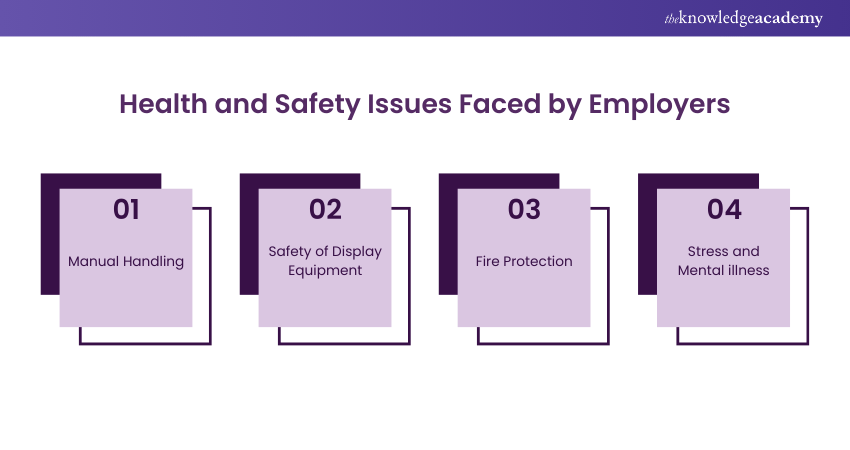
1) Manual Handling
Manual handling is used in many jobs like construction, manufacturing and much more, but it also raises safety concerns. If a few handle a heavy object requiring more machinery or people, the chances of encountering injuries increase. On the contrary, there are better solutions than banning manual handling. The correct answers can be implementing robust Health and Safety in Construction and manufacturing including proper training and the use of appropriate equipment, is crucial to minimize the risks associated with manual handling.
It is also essential to understand the perspective of an Employee doing the groundwork because they know one more personal level. If workers are offered a chance to ask for the safety equipment that they feel is vital, issues like manhandling can be solved quickly.
2) Safety of Display Equipment
It is essential to have a good training course before Employees start working with delicate items like display equipment. Damaging these items can be risky for the Employees and cause financial damage to an organisation.
Display equipment like LED screens requires delicate handling. Other objects like mice and keyboards also require better care and precaution. Risk Assessment is something that can help an Employer in such cases. NEBOSH Risk Assessment is a vital component in the safety programs. After the assessment is completed, the Employer can be confident and decide which Employees are better suited for a particular job.
3) Fire Protection
Once started, fire can cause the most damage to a warehouse, factory or any other industry. It is also something that can endanger a person’s life. Therefore, it is always advisable to have a fire extinguisher, even if the chances of catching fire are minimal. Employers should regularly train the workers to handle objectives that evolve fire and use fire extinguishers effectively.
4) Stress and Mental Illness
Often, mental illness is regarded as non-threatening or a problem for an Employee on a personal level. But things like too much work-related stress, excessive workload, bullying and harassment can cause mental illness. Some of the many factors Employers can introduce to keep mental health in check are breaks, efficient workload, and a good work environment.
Kickstart your Health and Safety with our NEBOSH Award in Health and Safety at Work Course, Sign up now!
How to Maintain Health and Safety in the Workplace?
Maintaining Workplace Health and Safety in the Workplace demands the collective effort of everyone in the organisation. If everyone prioritises it, the organisation's productivity can also show its benefits. Here are a few key aspects that can help you maintain Health and Safety.
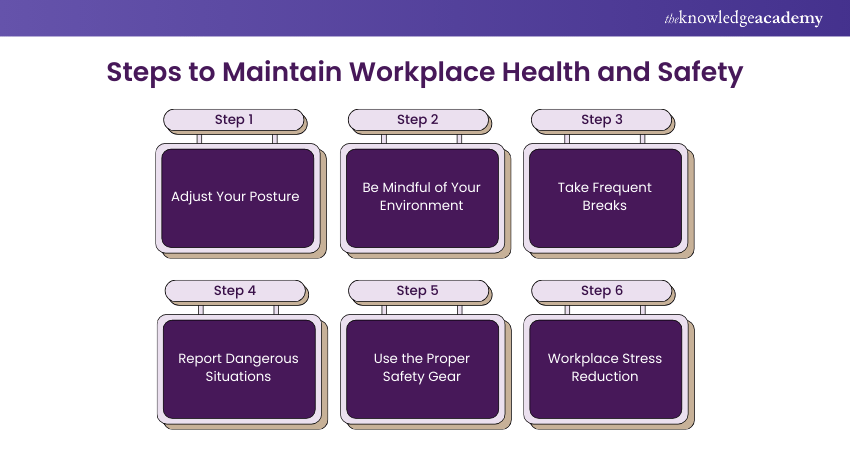
1) Adjust Your Posture
If you are going to sit at a desk for hours, why not model ensuring your comfort? Correct posture requires an Employee to sit straight with their knees on the level of their hips. Positioning the wrist closer so that the person sits with rested elbows also makes a great posture.
2) Be Mindful of Your Environment
Even when all the requirements are fulfilled, a lack of attention can cause great harm. Being attentive while working on vast machinery, surrounded by wiring, or engaging in any other dangerous activity saves workers from injuries. Similarly, awareness is crucial in identifying workplace hazards, including discrimination in the workplace, which can negatively impact employees' well-being. It is also essential to be mindful of any potential danger lurking around that still needs fixing.
3) Take Frequent Breaks
Breaks are a good source of relief in a stressful work environment. It helps Employees deal with the ongoing street, have a few laughs and relax their minds with the constant traffic of thoughts. Breaks also allow a person to stretch and prevent injuries.
4) Report Dangerous Situations
Not taking responsibility for reporting a dangerous issue can lead to serious consequences for both yourself and those around you. Proper Incident Reporting highlights critical setbacks, restores efficiency, and ensures that safety remains a priority.
5) Use the Proper Safety Gear
Safety gear is designed to keep the dangerous aspect of the work away from a person. But when safety gear itself isn’t worth having, the danger can cause damage. This is why using proper safety gear that everyone can rely on is so important.
6) Workplace Stress Reduction
It is considered normal to undergo some stress when you are dealing with meaningful work. But if you face a lot of stress in the work environment, you should talk to your Superiors or Manager. A company that runs over stress can commit damages and decrease productivity.
Gain expertise in conducting Safety Audits and inspections effectively in our comprehensive IOSH Courses - Register now!
What is Occupational Health?
Occupational Health is a branch in medicine that focuses on the physical, mental and social well-being of employees in all the workplace. Its main objective are the maintenance and promotion of Employee's health and working capacity. Also, improvement of working conditions and environment to become advantageous to Health and Safety.
Role of Leadership in Workplace Safety
The following table summarises the role that leadership plays in ensuring safety in the workplace:
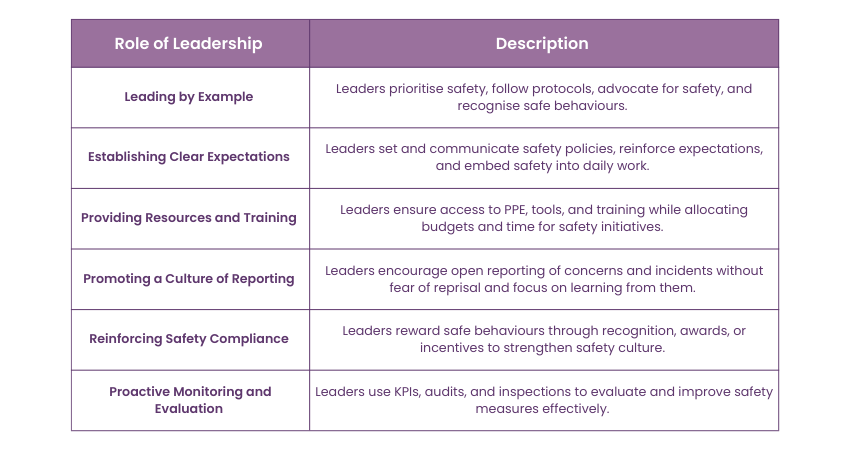
Who are the Key Health and Safety Organisations?
The two most important globally recognised Health and Safety organisations are IOSH and NEBOSH.
1) IOSH: The Institute of Safety and Health (IOSH) help people in all sectors stay healthy and safe at workplace. There are two IOSH courses are available: Working Safely and Managing Safely.
2) NEBOSH: The National Examination Board in Occupational Safety and Health (NEBOSH) offers globally recognised courses in health and safety. These courses equip managers, supervisors, and employees with the knowledge and skills to handle various workplace safety and health challenges. .
Benefits of a Safe Workplace
Addressing health and safety offers substantial opportunities and benefits, including the following:
1) Reduced costs and risks.
2) Lower Employee absence and turnover rates.
3) Better reputation for corporate responsibility among customers, investors and communities.
4) Fewer accidents and lessened threat of legal action.
5) Improved standing among partners and suppliers.
6) Increased productivity due to healthier, happier and better-motivated Employees.
What Colour are Mandatory Signs?
Mandatory safety signs are red. They fall among these categories:
1) Mandatory safety signs (Blue)
2) Fire safety signs (Red)
3) Prohibition Safety Signs (Red)
4) Emergency Escape/First Aid Safety Sign (Green)
5) Warning Safety Signs (Yellow)
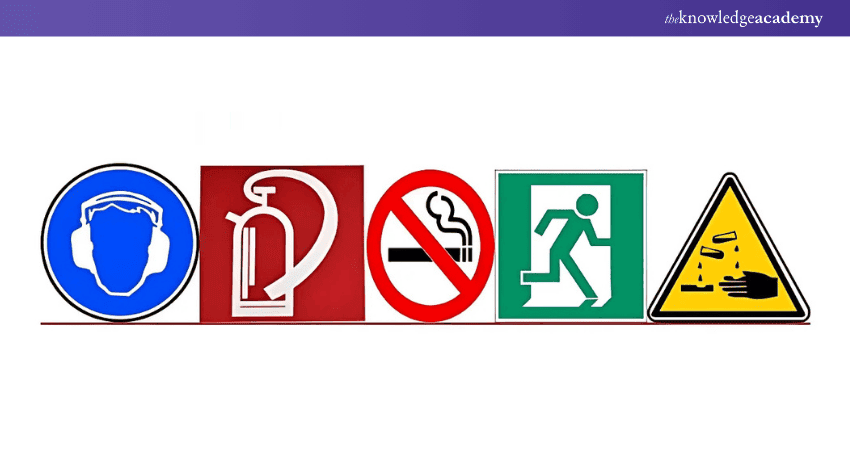
What do the 3 P's of First Aid Stand for?
The 3 P’s of First Aid stand for:
1) Preserve: This involves the primary goal of keeping the person alive.
2) Prevent: This involves preventing the victim's condition from worsening.
3) Promote Recovery: This includes actions that help the person recover.
Looking to ace your interview? Check out these essential Health and Safety Interview Questions and Answers to prepare effectively.
Conclusion
Health and Safety in the Workplace play a critical role in creating a safe, productive, and ethical work environment, especially in a Hybrid Workplace Strategy. Prioritising the well-being of Employees is not only a legal obligation but a moral imperative. Through effective implementation of Health and Safety measures, organisations protect Employees from potential hazards, reduce the risk of accidents and injuries, and promote their overall well-being in both remote and on-site settings.
Boost your career in Occupational Health and Safety with our NEBOSH International General Certificate in Occupational Helath and Safety Training- Sign up now!
Frequently Asked Questions
What are the Four C’s in Health and Safety?

Here are the four C's of Health and Safety:
a) Competence
b) Control
c) Co-operation
d) Communication
What are the Seven Key Areas of Health and Safety?

The key areas of Health and Safety include Risk Assessments, safety policies, workplace hazards, Employee training, accident prevention, emergency procedures and regulatory compliance.
What are the Other Resources and Offers Provided by The Knowledge Academy?

The Knowledge Academy takes global learning to new heights, offering over 3,000 online courses across 490+ locations in 190+ countries. This expansive reach ensures accessibility and convenience for learners worldwide.
Alongside our diverse Online Course Catalogue, encompassing 19 major categories, we go the extra mile by providing a plethora of free educational Online Resources like News updates, Blogs, videos, webinars, and interview questions. Tailoring learning experiences further, professionals can maximise value with customisable Course Bundles of TKA.
What is the Knowledge Pass, and How Does it Work?

The Knowledge Academy’s Knowledge Pass, a prepaid voucher, adds another layer of flexibility, allowing course bookings over a 12-month period. Join us on a journey where education knows no bounds.
What are the Related Courses and Blogs Provided by The Knowledge Academy?

The Knowledge Academy offers various IOSH Courses, including IOSH Managing Safely Course and IOSH Working Safely Course. These courses cater to different skill levels, providing comprehensive insights into Importance of Safety at Workplace.
Our Health and Safety Blogs cover a range of topics related to IOSH, offering valuable resources, best practices, and industry insights. Whether you are a beginner or looking to advance your Health and Safety skills, The Knowledge Academy's diverse courses and informative blogs have you covered.
Upcoming Health & Safety Resources Batches & Dates
Date
 IOSH Managing Safely Course
IOSH Managing Safely Course
Mon 28th Apr 2025
Mon 16th Jun 2025
Mon 28th Jul 2025
Mon 1st Sep 2025
Mon 3rd Nov 2025






 Top Rated Course
Top Rated Course



 If you wish to make any changes to your course, please
If you wish to make any changes to your course, please


